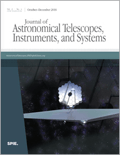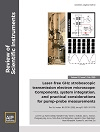
Journal of Astronomical Telescopes Instruments and Systems
metrics 2024
Pioneering Discoveries in Astronomy and Optical Sciences
Introduction
Journal of Astronomical Telescopes Instruments and Systems is a prestigious academic journal published by SPIE-SOC PHOTO-OPTICAL INSTRUMENTATION ENGINEERS, focusing on groundbreaking research in the fields of astronomy and astrophysics, instrumentation, and optical sciences. With an ISSN of 2329-4124 and an E-ISSN of 2329-4221, this journal has steadily established its relevance in the scientific community, achieving a respectable Q2 ranking across various important categories, including Astronomy and Astrophysics and Control and Systems Engineering in the year 2023. Spanning research from its inception in 2015 to projections through 2024, the journal continues to serve as a critical platform for disseminating innovative findings that advance our understanding of astronomical instruments and systems. As researchers, professionals, and students seek to stay at the forefront of technological advancements and scientific inquiries, the Journal of Astronomical Telescopes Instruments and Systems is an invaluable resource. The journal provides a valuable venue for peer-reviewed articles that stimulate discussion and drive forward the exploration of astronomical phenomena and instrumentation techniques, making it essential reading for those invested in the future of space sciences.
Metrics 2024
 0.58
0.58 1.70
1.70 1.60
1.60 33
33Metrics History
Rank 2024
Scopus
IF (Web Of Science)
JCI (Web Of Science)
Quartile History
Similar Journals

Advances in Astronomy and Space Physics
Navigating the Depths of Astronomy and Space Physics.Advances in Astronomy and Space Physics is an esteemed journal dedicated to the exploration and dissemination of research in the expansive fields of astronomy and space science. Published by Taras Shevchenko National University of Kyiv, this journal provides a platform for researchers, professionals, and students to share groundbreaking studies and innovations. With an ISSN of 2227-1481, it covers a wide range of subjects including astrophysics, planetary sciences, and space exploration technologies, thereby fostering interdisciplinary collaboration. Although not an Open Access journal, it maintains a commitment to high-quality, peer-reviewed content that contributes significantly to the advancement of scientific knowledge. The journal's mission is to promote sustainable practices in space research while also exploring the implications of discoveries on Earth and beyond. By maintaining rigorous publication standards, Advances in Astronomy and Space Physics aims to serve as a critical resource for those involved in the ever-evolving study of our universe.

REVIEW OF SCIENTIFIC INSTRUMENTS
Advancing the Frontiers of Scientific MeasurementWelcome to the Review of Scientific Instruments, an esteemed journal published by AIP Publishing that has been a cornerstone in the field of scientific instrumentation since its inception in 1930. With an ISSN of 0034-6748 and E-ISSN of 1089-7623, this journal serves as a vital platform for the dissemination of innovative research and advancements in both Instrumentation and Medicine, categorized in Q3 quartiles in 2023. The journal has proudly maintained its relevance, forecasting continued publication through 2024, while providing critical insights that influence contemporary practices in various scientific domains. The impact factor reflects its contribution to the academic community, making it an invaluable resource for researchers and professionals seeking to stay at the forefront of scientific progress. Although Access is not open, the rigorous peer-review process ensures that published works are of the highest quality, making the Review of Scientific Instruments a must-read for anyone involved in the intricate world of experimental science and technological innovations.

Geoscientific Instrumentation Methods and Data Systems
Unlocking New Frontiers in Geoscience Methodologies and TechnologiesGeoscientific Instrumentation Methods and Data Systems, published by COPERNICUS GESELLSCHAFT MBH, is a distinguished open-access journal dedicated to the dissemination of innovative methodologies, advanced instrumentation, and comprehensive data systems in the earth sciences. With an ISSN of 2193-0856 and an E-ISSN of 2193-0864, this journal has been paving the way for insightful research since its inception in 2012. Based in Germany, it serves a global audience interested in atmospheric science, geology, and oceanography, reflected in its impressive Scopus rankings and recent categorizations as Q2 and Q3 in these vital fields. The journal’s mission is to foster interdisciplinary collaboration and facilitate knowledge exchange, providing a platform for researchers and professionals to share significant advancements and challenge the frontiers of geoscientific instrumentation and methods. As an open-access journal, it ensures that pivotal research findings are accessible to a wider audience, promoting inclusivity and rapid dissemination of knowledge critical to addressing global challenges in earth and planetary sciences.

NUCLEAR INSTRUMENTS & METHODS IN PHYSICS RESEARCH SECTION A-ACCELERATORS SPECTROMETERS DETECTORS AND ASSOCIATED EQUIPMENT
Pioneering research in nuclear methods and technologies.NUCLEAR INSTRUMENTS & METHODS IN PHYSICS RESEARCH SECTION A is a leading journal published by Elsevier, dedicated to the advancements in accelerators, spectrometers, detectors, and associated equipment relevant to the fields of nuclear and high energy physics. With its ISSN 0168-9002 and E-ISSN 1872-9576, this journal fosters knowledge sharing among physicists and researchers globally, providing a critical platform for both theoretical and experimental studies. Currently ranked in the Q2 quartile for both Instrumentation and Nuclear and High Energy Physics, the journal maintains a robust position in the competitive Scopus rankings, with noteworthy placements that underline its scholarly impact. As of 2023, it occupies the 38th rank in Nuclear and High Energy Physics and the 79th in Instrumentation, illustrating its relevance in the scientific community. Covering research spanning from its inception in 1983 to the projected completion in 2024, the journal caters to a diverse audience of researchers, professionals, and students eager to stay abreast of the latest innovations and techniques in the realm of nuclear instrumentation. Although it primarily operates under subscription-based access, it is instrumental in disseminating pivotal findings and experimental methodologies that drive progress in the scientific community.

Journal of Instrumentation
Unveiling cutting-edge discoveries in measurement techniques.Journal of Instrumentation, published by IOP Publishing Ltd, stands at the forefront of the fields of instrumentation and mathematical physics, playing a crucial role in advancing the knowledge and practice within these domains. With an ISSN of 1748-0221 and an esteemed position as a Q2-ranked journal in both categories as of 2023, it showcases high-quality research and innovative findings that contribute to the broader scientific community. Operating since 2006, this journal facilitates the dissemination of cutting-edge developments and interdisciplinary approaches in measurement techniques and their applications, making it a vital resource for researchers, professionals, and students alike. The journal maintains a competitive edge, ranked in the 59th percentile in mathematical physics and the 35th percentile in instrumentation according to Scopus rankings, reflecting its commitment to quality and impact. With a focus on accessible scientific communication, the Journal of Instrumentation is dedicated to nurturing a collaborative environment that promotes the integration of theoretical advancements and practical issues, providing an essential platform for sharing vital research discoveries.

Bulgarian Astronomical Journal
Illuminating the Universe Through ResearchThe Bulgarian Astronomical Journal, published by the BULGARIAN ACADEMY OF SCIENCES, INSTITUTE OF ASTRONOMY, serves as a vital platform for the dissemination of research in the field of Astronomy and Astrophysics. With the ISSN 1313-2709 and E-ISSN 1314-5592, this journal has been pivotal in showcasing original studies and advancements in astronomical sciences from 2014 and will continue to do so through 2025. Although categorized in Q4 within the ambit of Astronomy and Astrophysics, it provides essential insights and innovative findings, making significant contributions to the global academic community. Positioned in the lower quartile of Scopus rankings, recognized as #87 out of 90, it offers an opportunity for burgeoning researchers and seasoned professionals alike to engage with emerging ideas and trends in the discipline. While it currently does not feature an open access model, readers and contributors can anticipate a rich exchange of scientific knowledge that fosters collaboration within the astronomy community.

Serbian Astronomical Journal
Exploring the Cosmos, One Discovery at a TimeSerbian Astronomical Journal, published by the Astronomical Observatory Belgrade, serves as a significant platform for research and innovation within the field of astronomy and astrophysics. With an established publication history since 1992 and an Open Access model, the journal ensures that its cutting-edge research is accessible to a global audience. The journal is recognized for its contribution to the scientific community, evidenced by its solid position in the 2023 Scopus category quartiles, ranking Q3 in Astronomy and Astrophysics. This positions it among notable journals in the discipline, despite being at the 18th percentile of its category rankings. Researchers, professionals, and students will find in Serbian Astronomical Journal a valuable resource for disseminating findings, exploring new discoveries, and engaging with contemporary challenges in astronomy. As the journal continues to evolve, it remains dedicated to advancing the knowledge and understanding of the universe.

Journal of Astronomical Instrumentation
Connecting Research and Technology in the World of AstronomyThe Journal of Astronomical Instrumentation, published by WORLD SCIENTIFIC PUBL CO PTE LTD, is a pioneering peer-reviewed journal that has established itself as a vital outlet for the dissemination of research in the fields of astronomy and astrophysics, as well as in instrumentation technologies. Since its inception in 2012, this international journal has provided a platform for researchers and practitioners to share their findings, innovations, and insights pertaining to astronomical tools and techniques. With an esteemed Q3 categorization in both Astronomy and Astrophysics and Instrumentation for 2023, it ranks within the top tier of journals in these disciplines, demonstrating its impact and relevance in the scholarly community. Covering a broad range of topics that encompass the design, development, and application of astronomical instruments, the journal also emphasizes technological advancements that enhance observational capabilities. Researchers, professionals, and students alike will find this journal an invaluable resource for staying abreast of current trends and breakthroughs in the field of astronomical instrumentation.

PUBLICATIONS OF THE ASTRONOMICAL SOCIETY OF JAPAN
Connecting scholars to the wonders of the universe.Publications of the Astronomical Society of Japan is a prestigious, peer-reviewed journal dedicated to advancing the field of astronomy and astrophysics. Published by Oxford University Press, this journal provides a platform for high-quality research, fostering scientific communication among both established researchers and emerging scholars. With an ISSN of 0004-6264 and E-ISSN 2053-051X, it is recognized for its significant impact in its field, boasting a Q2 ranking in both Astronomy and Astrophysics and Space and Planetary Science as of 2023. The journal seeks to bridge traditional and innovative approaches to expand understanding of celestial phenomena, making it an essential resource for professionals, students, and researchers alike. Researchers can access a wealth of cutting-edge studies spanning theoretical and observational aspects of astronomy from its inception in 1996 to the present day. Although the journal operates under a traditional access model, it remains a respected forum for pivotal discoveries and discussions within the global astronomical community.

Optica Pura y Aplicada
Pioneering Research in the Realm of OpticsOptica Pura y Aplicada, published by the SOC ESPANOLA OPTICA, stands as a vital platform for the dissemination of cutting-edge research in the fields of Atomic and Molecular Physics, Optics, and related engineering disciplines. Established in Spain, this journal aims to foster the advancement of knowledge in optical science and technology by providing a rigorous peer-reviewed publication outlet for scholars, researchers, and practitioners. Despite being categorized in the Q4 quartile across multiple domains, including Engineering and Materials Science, the journal remains committed to contributing meaningful insights and advancements within its scope. With an ISSN of 0030-3917 and an E-ISSN of 2171-8814, the journal effectively reaches a global audience eager to explore innovative applications and theoretical developments in optics and materials science. Researchers and professionals alike will find in Optica Pura y Aplicada a valuable resource for enriching their understanding and practices in an ever-evolving field, fostering collaborations and promoting research growth until its converged conclusion in 2024.